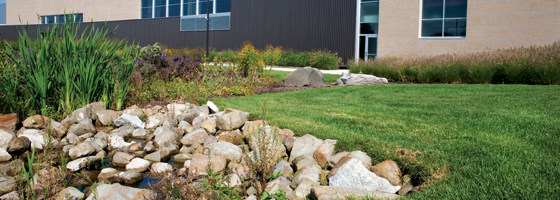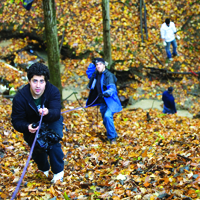Stormwater management cuts erosion in fragile ecosystem

In a strip of land between the Grand River and Grand Valley State University’s Allendale, Mich. campus, a system of ravines puts a significant wrinkle in the otherwise flat landscape. For Peter Wampler, an associate professor of geology who came to Grand Valley in 2004 from the mountains of Oregon, the folded hills of the ravines were welcome relief in a topographically challenged state.
“The ravine systems are really incredible,” Wampler said. “They’re unique. They’re really steep. There are parts you can barely walk up.”
The ravines, which drop 120 feet over a short distance, have given sanctuary to diverse plants and wildlife for thousands of years. But in the 1960s, the ravines gave university planners a convenient place to dump the stormwater that drains from campus after a heavy rain — a strategy has left the ravine floors scoured and slopes unstable.
Now, an effort to preserve this fragile natural feature has launched a campus-wide push for progressive stormwater management and monitoring.
Since the school opened in the ‘60s, its drainage network has concentrated stormwater into a few outflow pipes that send torrents rushing down the ravine floors, washing away soil and potentially collapsing banks. Soil that washes out of the ravines ends up in the Grand River, where it can cloud the water and smother habitat for fish and other aquatic organisms. Summer 2011 saw the first round of sediment sampling in the river, which gave researchers a look at how big the problem is.
“We have good numbers now, and they’re pretty staggering numbers, the amount of sediment that’s being generated by that system,” Wampler said.
Not all the erosion is unnatural. The system has likely always moved some sediment into the river — that’s what formed the ravines in the first place. But the university’s past stormwater management practices have made it worse.
“I think we’ve certainly accelerated the process,” he said. “The erosion has gotten more dramatic, more flashy and more episodic than it probably was historically.”
Since 2006, a network of monitoring gauges that continuously record flow or stage height throughout the ravines has helped characterize just how flashy the runoff has become. One way Wampler has done this is by calculating lag times, or the amount of time it takes for runoff to reach its peak flow after a rain event. Lag times in natural, undeveloped watershed tend to be relatively long because water is absorbed by plants and soil, slowing its movement through the system. Lag times in urbanized watersheds are relatively short because paved surfaces and pipes speed the water along.
Rainfall and stage height data collected during a storm in 2006 show a lag time of around 50 minutes in one of the runoff-impacted ravines. Similar data from an off-campus, undeveloped creek monitored as a control found a lag time between 250 and 1,400 minutes.
Though the data describing the problem are fairly recent, the school has been rethinking its stormwater management since the 1990s after a massive pipe failure and conspicuous erosion. By 2002 they had a new stormwater plan and launched erosion-control efforts in the ravines. They installed structures to slow the velocity of water as it blasted from the outflow pipes. They laid down a layer of rocky riprap on ravine floors to secure the soil.

Photo: Amanda Pitts
But the erosion persisted. Water found its way around the dams and limestone riprap was breaking down. “They spent a lot of money for a lot of years trying to put Band-Aids on this gaping wound down there,” Wampler said. “And really, none of it has worked and it’s still not working.”
By trying to line the ravines with rock and slow the water once it was already in the ravines, the fixes were already too late. Instead, they needed to keep the water out of the ravines in the first place.
That goal has been at the center of a sea change in stormwater management at Grand Valley over the past decade. In 2006, the university created a committee called the Stormwater Advisory Group, whose members include students, faculty and representatives from Facilities Services, the university department responsible for planning and maintenance. The group created a new comprehensive management plan that guides stormwater control. Wampler credits the turnaround to improved data and communication, and especially the initiative of Facilities Services to make the problem a priority.
“The thing driving all this is that Facilities has made a conscious, verbal and public commitment to return the campus to 1960s runoff levels,” he said. “Any new construction on campus, the runoff control will actually turn back the clock.”
Facilities is meeting that commitment through best management practices like building green roofs that absorb water and parking lots of porous asphalt that allow rain to seep through. On the grounds of the LEED-certified Laker Turf Building, which was built in 2008 for student recreation, stormwater is directed into a 9,000 square-foot rain garden that takes a big bite out of the runoff.
Another series of monitoring gauges helps show how well the rain garden works. A hydrograph generated from the data shows that during a 2009 rain event, water flowing into the rain garden hit a peak of 1,200 gallons per minute. The outflow never rose above 200 gallons per minute.
“It’s amazingly effective,” Wampler said. “I was a bit skeptical, to be honest, about these rain gardens. But I was proven wrong, especially with this one.”
In the rain garden, much of the water percolates into the ground or is taken up by native plants. Water that manages to escape the garden is captured by a pond and used for irrigation.
The single biggest change in campus stormwater management is a constructed wetland completed in the summer of 2011. Around 25 percent of the runoff flowing into one of the ravines has been diverted into the wetland, which Wampler sees as the next target for monitoring gauges if funding becomes available.
In the meantime, the university’s advancements in curbing runoff have been an important educational opportunity for students to learn about environmental processes and planning. Dozens of classes have implemented some manner of stormwater component, and Wampler said he takes almost every class he teaches on a “ravine romp” and rain garden tour. Some classes get a chance to evaluate rain garden data and gauge its effectiveness themselves.
“It’s great for students. They really appreciate seeing real problems and real solutions being applied,” he said. “And it’s an evolving story, so I can tell them how things have changed and how things are progressing from where they were.”





0 comments